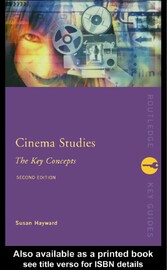
Cinema Studies: The Key Concepts

von: Susan Hayward
Routledge, 2001
ISBN: 9780203179932
Sprache: Englisch
549 Seiten, Download: 2316 KB
Format: PDF, auch als Online-Lesen
G (p.153-154)
gangster/criminal/detective thriller/private-eye films (see film noir)
and the separate entry for thriller; see also psychoanalysis) These different titles point to the difficulty of allocating a single generic name to a set of types of film – a difficulty due primarily, as we shall see, to the shifting contexts in which a particular genre finds itself and which dictate that it must change its system of signification.
The gangster film is the one most readily identified as an American genre even though the French film-maker Louis Feuillade’s Fantômas (1913–14) is one of the earliest prototypes. It is in the contemporaneity of its discourses that the gangster film has been so widely perceived as an American genre. This genre, which dates from the late 1920s, came into its own with the introduction of sound and fully blossomed with three classics in the early 1930s: Little Caesar (Melvyn LeRoy, 1930), The Public Enemy (William A. Wellman, 1931) and Scarface (Howard Hawks, 1932). In the United States this was the period of Prohibition (1919–33), during which the manufacture, sale and transportation of alcoholic drinks was forbidden, and the Depression (1929–34), when worldwide economic collapse precipitated commercial failure and mass unemployment.
These two major events in the United States’s socio-economic history helped to frame the mythical value of the gangster in movies. Prohibition proved impossible to enforce because gangsters far outnumbered the law enforcers. Prohibition, however, brought gangsters and their lifestyle into the limelight as never before. Gang warfare and criminal acts became part of the popular press’s daily diet and soon became transferred on to film. In fact, many of the gangster films of that period were based on real life. Gangsterism viewed from this standpoint was about greed and brutal acts of violence – in summary about aggression in urban society. But the gangster movies were not as straightforwardly black and white as that. The male protagonist embodied numerous contradictions that made spectator identification possible. If we look to the second socio-economic factor mentioned above, we can find a possible reason for the complex and nuanced characterization of the gangster-hero.







